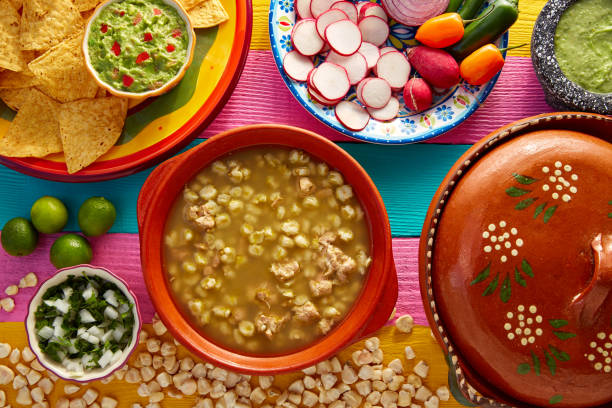Pozole verde is more than just a dish; it is a celebration of Mexican culture, a culinary experience steeped in history and flavor. This vibrant soup, rich in both taste and tradition, has captured the hearts of many around the world. In this article, we’ll explore the origins of pozole verde, its ingredients, preparation methods, cultural significance, and some tips for serving this delightful dish.
The Origins of Pozole
Pozole, which means “hominy” in Nahuatl, has its roots in pre-Columbian Mexico. Traditionally, it was made from nixtamalized corn, a process that involves soaking and cooking corn in an alkaline solution, which makes it more nutritious and easier to grind. The dish was often prepared for special occasions and was considered a sacred food, associated with various rituals and celebrations.
Historically, pozole was made using different types of meat, depending on the region and the availability of ingredients. While the red version of pozole is more widely recognized, pozole verde, characterized by its green color, comes from a unique blend of ingredients that sets it apart. The green hue is achieved primarily through the use of tomatillos, green chilies, and cilantro, which not only add flavor but also create a visually stunning dish.
Ingredients of Pozole Verde
The Essential Components
To make authentic pozole verde, a few key ingredients are essential. The primary base is hominy, which can be found canned or dried. Dried hominy requires soaking and cooking for several hours, while canned hominy can be added directly to the pot.
The meat traditionally used in pozole verde is chicken or pork, although variations exist. The choice of meat adds depth to the broth, contributing to the overall flavor profile of the dish.
The Green Sauce
The vibrant green color of this pozole comes from the green sauce made primarily from tomatillos. Tomatillos are small, green fruits enveloped in a husk, with a tart flavor that brightens the dish. Alongside tomatillos, fresh green chilies, such as jalapeños or serranos, are blended into the sauce, providing a spicy kick.
Cilantro and garlic are also critical components of the sauce, lending aromatic qualities that enhance the overall flavor. Some recipes may include avocado leaves, which add a distinctive earthy taste.
Toppings and Accompaniments
The beauty of pozole verde lies not just in its preparation, but also in the toppings that accompany it. Common garnishes include sliced radishes, diced onions, shredded cabbage, and a generous squeeze of lime. These toppings provide a delightful contrast to the warm, rich broth, adding crunch and freshness.
In addition, avocado slices and crushed tortilla chips or tostadas are often served alongside pozole, allowing diners to customize their experience. The combination of textures and flavors makes each bowl of pozole verde a unique culinary adventure.
Preparation of Pozole Verde
Cooking the Hominy
The preparation of pozole verde begins with the hominy. If using dried hominy, it should be soaked overnight and then simmered until tender. This process can take several hours, so planning ahead is crucial. Canned hominy, on the other hand, simply needs to be rinsed and can be added directly to the pot.
Making the Green Sauce
While the hominy is cooking, the green sauce can be prepared. Start by roasting tomatillos, garlic, and green chilies until charred. This roasting process intensifies the flavors, bringing out the natural sweetness of the ingredients. After roasting, blend them together with fresh cilantro until smooth.
Cooking the Meat
Next, the chosen meat needs to be cooked. If using chicken, it can be boiled with aromatics like onion and garlic to create a flavorful broth. For pork, the meat can be seared and then simmered until tender. Once cooked, the meat is shredded or cut into bite-sized pieces.
Combining the Ingredients
Once all components are ready, it’s time to combine them. In a large pot, the cooked hominy is added to the broth, followed by the green sauce. This mixture is simmered for about 30 minutes to allow the flavors to meld together beautifully.
Serving Pozole Verde
When serving pozole verde, it’s important to provide an array of toppings. Guests can personalize their bowls, adding the garnishes they prefer. The result is a colorful, flavorful dish that is perfect for gatherings and celebrations.
Cultural Significance of Pozole Verde
A Dish for Celebrations
Pozole verde is often associated with special occasions and gatherings in Mexican culture. Whether it’s a family reunion, a holiday celebration, or a birthday party, this dish is a centerpiece that brings people together. Its rich flavors and communal nature make it ideal for sharing.
Regional Variations
While the version of pozole verde we’ve discussed is widely recognized, regional variations exist throughout Mexico. In some areas, different meats or spices are used, and the preparation methods can vary as well. Each region has its unique take on this traditional dish, reflecting local ingredients and culinary traditions.
Contemporary Adaptations
In recent years, pozole verde has gained popularity outside of Mexico, leading to adaptations and variations. Many chefs and home cooks experiment with the ingredients, adding personal touches to create new flavors while honoring the traditional roots of the dish. Vegetarian and vegan versions have also emerged, using alternative proteins and plant-based ingredients to cater to different dietary preferences.
Tips for Making the Perfect Pozole Verde
Choosing Quality Ingredients
For the best flavor, it’s essential to use high-quality ingredients. Fresh tomatillos, ripe avocados, and flavorful herbs can make a significant difference in the final dish. If possible, source ingredients from local markets for the freshest produce.
Balancing Flavors
Achieving the perfect balance of flavors is crucial in pozole verde. Taste the broth as it simmers and adjust the seasoning as needed. A touch of salt, a squeeze of lime, or an extra handful of cilantro can elevate the dish to new heights.
Preparing Ahead of Time
Pozole verde can be made ahead of time, making it an excellent choice for gatherings. The flavors often deepen and improve when allowed to sit, so consider making it a day in advance. Simply reheat before serving and add fresh toppings for a vibrant presentation.
Pairing Beverages with Pozole Verde
Traditional Beverages
When it comes to pairing beverages with pozole verde, traditional Mexican drinks enhance the dining experience. One classic option is aguas frescas, which are light, refreshing beverages made from fruits, grains, or flowers. Popular choices include agua de jamaica (hibiscus tea) and agua de horchata (a sweet rice-based drink). These beverages provide a contrast to the richness of the pozole, cleansing the palate and complementing the flavors of the dish.
Alcoholic Options
For those who prefer alcoholic beverages, cerveza (beer) is a great choice. A light Mexican lager or a citrusy pale ale can refreshingly balance the hearty flavors of pozole verde. Additionally, a classic margarita—made with fresh lime juice, tequila, and a hint of sweetness—can elevate the meal, providing a zesty counterpart to the dish.
Wine Pairings
If wine is your preference, consider a chilled Sauvignon Blanc or a Verdejo. These white wines offer crisp acidity and citrus notes that pair well with the bright flavors of the green sauce. For a red option, a light-bodied Pinot Noir can complement the dish without overpowering it.
Pozole Verde in Popular Culture
Culinary Recognition
Pozole verde has gained significant recognition in culinary circles, celebrated by chefs and home cooks alike. Food festivals often feature this dish, showcasing its versatility and the artistry involved in its preparation. Cooking shows and food documentaries have highlighted traditional recipes, contributing to its popularity beyond Mexico.
Social Media Influence
Social media has played a crucial role in popularizing pozole verde, with food bloggers and influencers sharing vibrant photos and recipes. Platforms like Instagram and TikTok have created a space for culinary creativity, where home cooks share their unique takes on pozole verde, inspiring others to explore this traditional dish.
Community and Family
In many Mexican households, pozole verde is synonymous with family gatherings. Recipes are often passed down through generations, each family adding their personal touch to the dish. The communal nature of pozole encourages sharing, making it a beloved choice for celebrations and special occasions.
Conclusion
Pozole verde is a dish that embodies the essence of Mexican culinary traditions, weaving together history, flavor, and community. With its rich broth, vibrant green sauce, and an array of toppings, it offers a unique dining experience that celebrates the joy of sharing food with loved ones. Whether enjoyed at a festive gathering or a quiet family dinner, pozole verde is sure to bring warmth and satisfaction to the table. Embrace the tradition, explore the flavors, and savor every bowl of this delightful soup.


